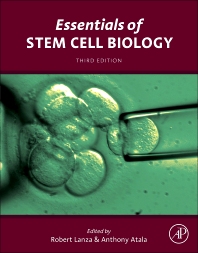Table of contents
Essentials of Stem Cell Biology, 3rd Edition
FOREWORD
Why Stem Cell Research?
A New Path ?{ Induced Pluripotent Stem Cells
Embryonic Stem Cells Versus Adult Stem Cells
'Stemness': Definitions, Criteria and Standards
PART ONE: INTRODUCTION TO STEM CELLS
1. Present Perspective and Future Challenges
2. Embryonic Stem Cells in Perspective
3. The Development of Epithelial Stem Cell Concepts
4. The Advent of Direct Reprogramming
5. Clinical Translation of Stem Cells
PART TWO: BASIC BIOLOGY/MECHANISMS
6. Molecular Basis of Pluripotency
7. Stem Cell Niches
8. Mechanisms of Stem Cell Self-Renewal
9. Cell Cycle Regulators in Stem Cells
10. Epigenetic Mechanisms of Cellular Memory
11. Cell Fusion and the Differentiated State
12. How Cells Change Their Phenotype
PART THREE: TISSUE AND ORGAN DEVELOPMENT
13. Differentiation in Early Development
14. Primordial Germ Cells in Mouse and Human
15. Stem Cells in Extraembryonic Lineages
16. Amniotic Fluid Derived Pluripotent Cells
17. Cord Blood Stem Cells
18. Neurogenesis in the Vertebrate Embryo
19. The Nervous System
20. Neuronal Progenitors in the Adult Brain
21. Sensory Epithelium of the Eye and Ear
22. Epithelial Skin Stem Cells
23. The Ontogeny of the Hematopoietic System
24. Hematopoietic Stem Cells
25. Red Blood Cells
26. Cell Differentiation in the Skeleton
27. Vascular Progenitor Cells
28. Multipotent Adult Progenitor Cells
29. Mesenchymal Stem Cells
30. Skeletal Muscle Stem Cells
31. Stem Cells and the Regenerating Heart
32. Potential of ES Cell Differentiation Culture for Vascular Biology
33. Cell Lineages and Stem Cells in the Kidney
34. Adult Liver Stem Cells
35. Pancreatic Stem Cells
36. Stem Cells in the Gastrointestinal Tract
37. Stem Cells in the Lung
PART FOUR: METHODS
38. Generation of Induced Pluripotent Stem Cells
39. Characteristics and Characterization of Pluripotent Stem Cells
40. Isolation and Maintenance of Murine Embryonic Stem Cells
41. Isolation, Characterization, and Maintenance of Primate ES Cells
42. Approaches for Derivation and Maintenance of Human ES Cells: Detailed Procedures and Alternatives
43. Derivation and Differentiation of Human EG Cells
44. Growth Factors & the Serum-Free Culture of Human Pluripotent Stem Cells
45. Feeder-Free Culture
46. Genetic Manipulation of Human Embryonic Stem Cells
47. Homologous Recombination in Human Embryonic Stem Cells
48. Surface Antigen Markers
49. Lineage Marking
50. Genomic Reprogramming
51. Isolation and Characterization of Hematopoietic Stem Cells
52. Microarray Analysis of Stem Cells and Differentiation
53. Zebrafish and Stem Cell Research
PART FIVE: APPLICATIONS
54. Cancer Stem Cells
55. Neural Stem Cells: Therapeutic Applications in Neurodegenerative Diseases
56. Spinal Cord Injury
57. Use of Embryonic Stem Cells to Treat Heart Disease
58. Insulin-Producing Cells Derived from Stem Cells: A Potential Treatment for Diabetes
59. Burns and Skin Ulcers 978-0-12-370465-8
60. Stem Cells and Heart Disease
61. Stem Cells for the Treatment of Muscular Dystropy
62. Skin Regeneration
63. Orthopaedic Applications of Stem Cells
64. Embryonic Stem Cells in Tissue Engineering
65. Adult Stem Cells in Tissue Engineering
66. Stem Cell Gene Therapy
PART SIX: REGULATION AND ETHICS
67. Ethical Considerations
68. Religious Considerations
69. Regulatory Considerations
70. It's Not About Curiosity, It's About Cures
Epilogue: Concluding Statement
Key Features
Contributions by Nobel Laureates and leading international investigators
Includes two entirely new chapters devoted exclusively to induced pluripotent stem (iPS) cells written by the
scientists who made the breakthrough
Edited by a world-renowned author and researcher to present a complete story of stem cells in research, in application,
and as the subject of political debate
Presented in full color with a glossary, highlighted terms, and bibliographic entries replacing references
Description
First developed as an accessible abridgement of the successful Handbook of Stem Cells, Essentials of Stem Cell Biology
serves the needs of the evolving population of scientists, researchers, practitioners, and students embracing the
latest advances in stem cells. Representing the combined effort of 7 editors and more than 200 scholars and scientists
whose pioneering work has defined our understanding of stem cells, this book combines the prerequisites for a general
understanding of adult and embryonic stem cells with a presentation by the world's experts of the latest research
information about specific organ systems. From basic biology/mechanisms, early development, ectoderm, mesoderm,
endoderm, and methods to the application of stem cells to specific human diseases, regulation and ethics, and patient
perspectives, no topic in the field of stem cells is left uncovered.
Readership
researchers, grad students, and professionals working with human stem cells in biology, tissue engineering, genetics,
cancer research, virology, immunology, and biotechnology


